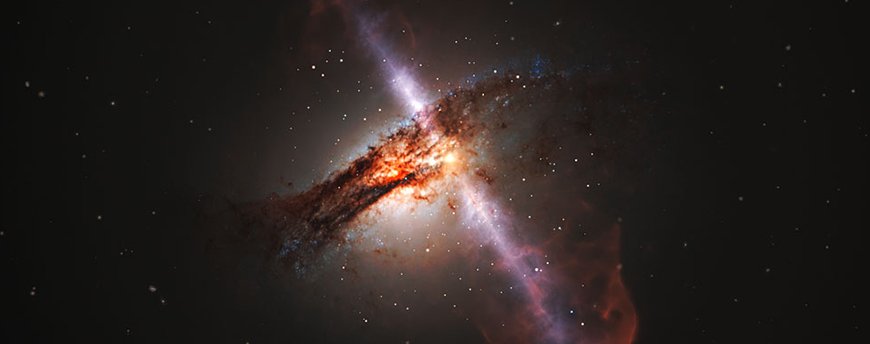In the vicinity of black holes so-called jets are often found: narrow streams that are aligned perpendicular to the rotating plates of matter around the gravity monsters throwing the particles into space almost at the speed of light. The formation of these jets is poorly understood. An international research team, in which a GFZ scientist is involved, has succeeded with the help of a virtual radio telescope to record such a jet with unprecedented resolution. They write about the findings in the journal Nature Astronomy. The underlying technique can also help to improve geodetic measurements.
The "close-up" of the jet in the center of the galaxy Perseus A at a distance of 230 million light years was achieved by the VLBI method. The abbreviation stands for Very Long Baseline Interferometry. Several radio telescopes are connected to take images of distant objects in space. The larger the distance between the radio telescopes (base line), the higher the resolution of the image. Usually, radio telescopes are virtually connected on Earth. The observation program RadioAstron also used an antenna on the Russian satellite Spektr-R. "The data needs to be corrected because the satellite is not stationary like a telescope on Earth. Due to its orbiting the planet, there are relativistic effects on the high-precision atomic clock on board, which must be taken into account," explains James Anderson from GFZ section of Space Geodetic Techniques and co-author of the study.
The correction of the measurement data was mainly done by Anderson who developed a related model during his research at the Max Planck Institute for Radio Astronomy (MPIfR) in Bonn. "Now we are able to achieve an angular resolution of only 30 micro-arc seconds. This compares to about the size of a tennis ball on the Moon viewed from Earth. " Although the jet in the Perseus galaxy is much farther away, the high resolution helped to study this distant object as well. It turned out that the jet is much wider at its base than current jet physics models predict. "By better understanding how these jets behave, and especially how jets evolve on time, we may be able to substantially improve the geodetic VLBI measurements," says Anderson. Originally researching distant objects at the MPIfR, now at GFZ he is working at the other end: here, the distant radio sources are used as reference points ("lighthouses") to measure the movement of tectonic plates or to determine the position of space crafts very precisely. (rn)
Original study: Giovannini, G., Savolainen, T., Orienti, M., Nakamura, M., Nagai, H., Kino, M., Giroletti, M., Hada, K., Bruni, G., Kovalev, Y.Y., Anderson, J.M., D’Ammando, F., Hodgson, J., Honma, M., Krichbaum, T.P., Lee, S.-S. , Lico, R., Lisakov, M.M., Lobanov, A.P., Petrov, L., Sohn, B.W., Sokolovsky, K.V., Voitsik, P.A., Zensus, J.A., Tingay, S., 2018. A wide and collimated radio jet in 3C84 on the scale of a few hundred gravitational radii. Nature Astronomy. DOI: 10.1038/s41550-018-0431-2








![[Translate to English:] Torsten Sachs in front of a climate station on a field](/fileadmin/_processed_/3/9/csm__TorstenSachs_bearbeitet_GS_4a1365ef84.jpeg)

![[Translate to English:] left image flood at the Ahrtal: image from above, several houses are flooded; left image:: Heidi Kreibich;](/fileadmin/_processed_/4/4/csm_Bild2_9af0130e9f.png)



![[Translate to English:] Start der Vega Rakete](/fileadmin/_processed_/6/4/csm_20231201-kachel_Vega-VV23-launch_ESA-CNES-Arianespace_706716b68c.jpeg)









![[Translate to English:] Poster exhibition at the Brandenburg Hydrogen Day at the GFZ, some participants in the foreground](/fileadmin/_processed_/6/5/csm_Erster_Brandenburgischer_Wasserstofftag_GFZ_402fcec95e.jpeg)
![[Translate to English:] Group picture of the participants](/fileadmin/_processed_/9/4/csm_20231108_CAWa-Workshop-Tashkent_Gruppenbild_99ea779d8a.jpeg)

![[Translate to English:] [Translate to English:] Hörsaal](/fileadmin/_processed_/e/6/csm_H%C3%B6rsal_e21ac645fb.jpeg)


![[Translate to English:] The Delegations in the Historic Library on the Telegrafenberg. In the back there are from left to right, the Dutch Ambassador for Germany, Ronald van Roeden, the Dutch Minister for Education, Culture and Science, Robbert Dijkgraaf and the scientific director of the GFZ, Susanne Buiter.](/fileadmin/_processed_/d/b/csm_Kachel-2_9eba4b4212.jpeg)

